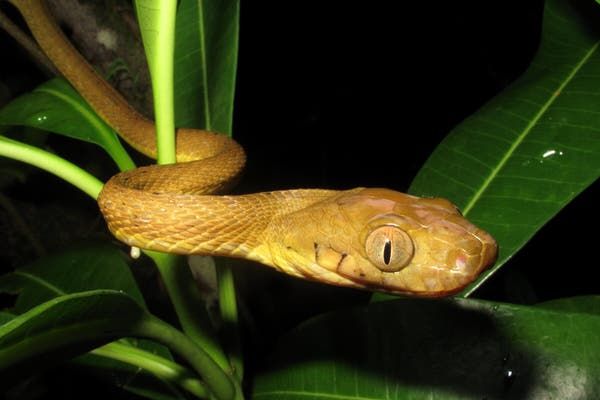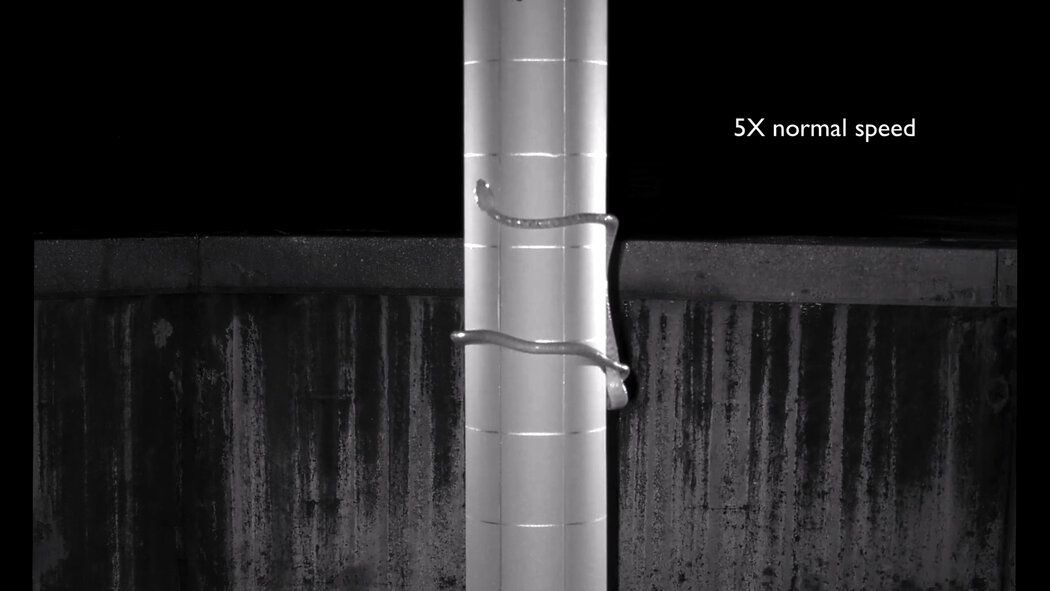These Snakes Found a New Way to Slither
The novel technique is great news for Guam’s brown tree snakes, bad news for the island’s nesting birds.


By Sabrina Imbler
- Published Jan. 11, 2021Updated Jan. 12, 2021
In 2016, on the northern tip of Guam, two biologists, Tom Seibert and Julie Savidge, challenged several brown tree snakes to a battle of wits. The arena: a concrete pen with a narrow metal pole. The prize, at the top of the pole: two mice, a seed cake and a potato in a cage. (The potato and seed cake were for the mice.) The obstacle: a three-foot-tall metal stovepipe baffle cinched around the pole like a cummerbund.
The biologists wanted to see if the baffle could protect nest boxes designed for Guam’s population of Micronesian starlings, which has been decimated since brown tree snakes were introduced in the late 1940s.
But while the scientists were sleeping, the nocturnal snake managed to wiggle up the pole, wrap its noodling body around the baffle almost like a lasso, and inch its way up toward the mice. Although the snake’s strategy of ascent has troubling implications for the conservation of the Micronesian starling, it also reveals an entirely new mode of snake locomotion that has never been described before. The researchers describe this new "lasso locomotion" in a study published Monday in Current Biology.
Dr. Seibert, a professor emeritus at Colorado State University, and his colleague Martin Kastner, also a biologist, made the discovery while reviewing time-lapsed infrared footage of the snake pit. The footage was initially boring, showing the snakes nosing around the bottom of the baffle but unable to climb it. Suddenly, several hours into the footage, one snake wrapped its body around the baffle, grabbed the end of its body with its tail, and wiggled its way up.
"We were bamboozled by what we were seeing," Dr. Seibert said, adding that he and Mr. Kastner kept replaying the video. "Snakes just don’t move this way."

Dr. Seibert asked Bjorn Lardner, a herpetologist who studies brown tree snakes on Guam, to see if he could figure out what the snakes were doing, but Dr. Lardner was stumped. Dr. Seibert sent the video to Dr. Savidge, also a professor emeritus at Colorado State University, to see if she had any idea. Dr. Savidge, who has studied these snakes for 30 years, was stumped.
In 2018, the researchers sent the video to Bruce Jayne, a snake locomotion biologist at the University of Cincinnati. "It was a real mind-bender," said Dr. Jayne, who is an author on the paper. "It just loops around the cylinder and then magically wiggles up." At first, he wondered if the snakes might be moving up the baffle the same way utility workers might scale a telephone pole using a belt and pushing off the pole with their feet. But, crucially, snakes do not have feet, so the idea went belly-up.
For almost a century, scientists have categorized snake locomotion into just four modes. In rectilinear locomotion, the snake moves in a straight line by stretching its skin and then sliding its skeleton forward. In lateral undulation, all points of the snake’s body bend from side to side. In sidewinding, snakes bend from side to side but also arch their back to lift their body from the ground. In concertina — aptly named after the accordion — the distance between the snake’s head and tail changes as the snake alternates between gripping something static and extending the rest of its body.
The brown tree snake’s movements seemed strange, but the time-lapse footage did not make it entirely obvious if the movements marked a new mode of locomotion. So in 2019, Dr. Seibert returned to Guam to replicate the experiment, this time with a 4K-resolution camera and two baffles stacked on top of each other.
The new video showed that a brown tree snake could climb the baffle by forming a loop with its body, crossing over itself at least once, and forming small bends in its body to inch its way up. The motion seemed to exhaust the snakes, which paused frequently, breathed heavily and sometimes slipped down the pole. After viewing the video, Dr. Jayne tried and failed to get the brown tree snakes in his lab to climb a pole using lasso locomotion. "Maybe they’ve gotten fat, old and lazy," he said.
Dr. Jayne believes lasso locomotion is an entirely new type of slithering. "Lasso locomotion is in outer space," he said. "It’s different enough that it doesn’t fit into any of the four categories." When a snake climbs a tree using concertina, the distance between its head and tail shrinks and swells as it alternates between gripping uphill and gripping downhill on the tree, sometimes at the same time. In contrast, in lasso locomotion, the looping region of the body the snake uses to grip does not change, and the animal moves itself upward with little sideways bends around the circumference of its cylinder.
"Given the right circumstances, it’s clear that snakes can find a way, and this new form of locomotion is an example of that," said Gregory Byrnes, a biologist at Siena College who was not involved with the research.
It’s possible that other snakes in the same genus as the brown tree snake are also capable of lasso locomotion, Dr. Jayne said. But one cannot simply walk into the woods and expect to observe a nocturnal snake using an exhausting and specific type of locomotion. "One of the problems of studying snakes is their secretive nature," he said. "We may not have observed the behavior in the wild because we’re barely observing the animals in the wild."
Although Dr. Savidge and Dr. Seibert were also amazed by lasso locomotion, their awe was tempered with the realization that they would need to take down all the nest boxes they had installed on narrow metal poles. Fruit-eating Micronesian starlings are one of two remaining native forest birds on Guam. "This bird is all there is," Dr. Savidge said. "There’s nothing else to disperse those native fruits in the forest anymore."
The researchers also tested a new baffle design shaped like an ice cream cone, wider at the top and narrower at the bottom. "Snakes cannot climb that," Dr. Seibert said, and so far, he’s been right.
[Like the Science Times page on Facebook. | Sign up for the Science Times newsletter.]